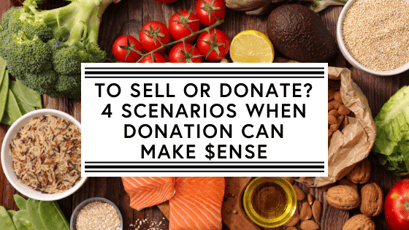
Diversification is a recommended best practice for managing financial risk. Similarly, leading food companies maximize value recovery from distressed inventory by maintaining a diverse network of outlets across discount, donation, and recycling destinations when surplus and distressed product becomes available.
However, even when access to alternative destinations is already in place, knowing which outlet will garner the highest financial return can be difficult. The decision is influenced by numerous factors - such as market fluctuations, product type, fair market value (FMV), and freight costs, not to mention vacation schedules and email/phone responsiveness from partners - that are hard to predict or outside of a company’s direct control.
This decision point is an area where Spoiler Alert spends a lot of energy and focus. While ultimately situational, we’ve identified four distinct scenarios when donating surplus inventory to hunger relief organizations is a stronger financial decision than selling on the closeout market. We highlight four below.
#1: Moving perishable product with resale restrictions is difficult.
In an earlier post, we shared how clearly communicating resale restrictions on the closeout market is an effective and necessary strategy to avoid market cannibalization. At the same time, these same restrictions can often be a barrier when attempting to sell this product, especially with highly perishable items (such as produce or dairy) that need to be moved within a tight timeframe. The situation is particularly challenging when restrictions mandate product be sold in a different region of the country. If the time it takes to find a buyer, negotiate a transaction, coordinate transportation logistics, ship product, and sell it to an end consumer is more than the remaining shelf-life, donating product is likely a better bet than paying for disposal. The food bank network across America does a phenomenal job of quickly and efficiently getting good product to soup kitchens, homeless shelters, and food pantries, where it can be consumed in a timely manner.
#2: Uniqueness of product leads to poor traction in the market.
Another scenario when donation can make more financial sense is when a product’s unique attributes lead to difficulty gaining market traction at a desired price. For example, certain ingredients, spices, or specialty products may be tough to sell because they appeal to a niche market that a closeout grocery store may not cater to, and/or the closeout price is still too high to attract any buyers in the secondary market. We’ve seen this happen with luxury items such as sea salts, when even at a 75% discount, the price was prohibitively high to be of interest to most buyers. Specialty produce is another example of a product often difficult to sell into secondary markets.
A recent IFDA report found that food distribution businesses generate $1,200 per square foot of warehouse space. Rather than sit on product taking up valuable space, contact your local food bank to see if they have interest in these items; they often have access to registered Dietitians or Nutritionists that can recommend easy-to-follow and nutritional recipes for unique donations. For example, the Greater Boston Food Bank operates the Click N’ Cook program that helps people browse healthy recipes using 1, 2, or 3 primary ingredients.
#3: An oversupply of product exists.
Like most food staples, prices on the closeout market are acutely influenced by the forces of supply-and-demand. Consequently, in the event of an oversupply of a given product or product category, it can be nearly impossible to move such product — even at a deep discount. This can be regularly observed with seasonal items (particularly around the Thanksgiving and Christmas holidays), as well as when international trade disputes and forces have material impacts on demand.
Two examples of this include the current cranberry glut that is occurring across the country, or the situation last summer when meat piled up in U.S. warehouses. When the market is saturated with a particular product, even if shelf-stable, a donation effort can be a great strategy, rather than sitting and waiting for favorable market dynamics. Within the hunger relief community, there is a push to increase access to value-added processing to significantly extend the shelf life of perishable products, which will enable these organizations to accept higher volumes of fresh product.
#4: The quantity is too low to pique buyer interest.
The final scenario we’ll highlight is situations in which low quantities of products are available for sale. Many companies struggle to generate secondary market demand for low quantities (e.g., 50-500 lbs, 5-50 cases, etc.) of various surplus products they’ve accumulated. These volumes might equate to less than a half-pallet of product, which can often make the unit economics of logistics unfavorable.
In these scenarios, companies generally have two options to avoid disposal: stockpile product until a sufficient quantity is reached (which is a difficult proposition for perishable product), or move forward with donations to a food recovery non-profit. Food pantries have the flexibility to carry a more diverse portfolio of fresh and shelf-stable items, particularly when the SKU count is high but quantities are low.
Diversity is key
Businesses are understandably motivated by the bottom-line, and discounting is a key piece to maximizing financial value recovery from distressed and surplus inventory. In light of the challenges highlighted throughout, it is imperative that food businesses maintain a diverse network of outlets across sales and donation as a means to consistently mitigate the financial impacts of at-risk inventory.
.png?width=250&name=SpoilerAlert_WhiteLogo_LeftStacked%20(7).png)
